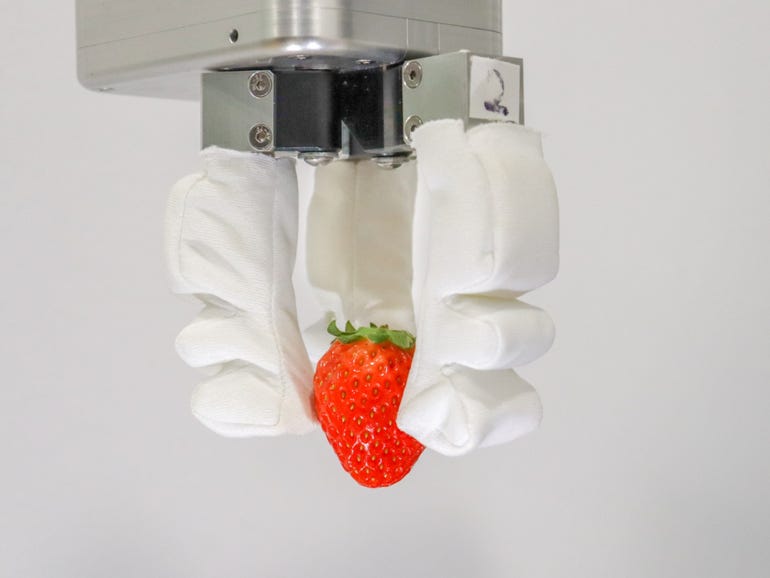[ad_1]
Engineers at the National University of Singapore (NUS) built a robotic system that they say can grip a variety of objects, from soft and delicate to bulky and heavy. The configurable robotic hand is intended to meet the requirements of industries such as vertical farming, food assembly and fast-moving consumer goods packaging with an efficiency increase of 23%.
These industries are increasingly automating their processes, but according to NUS currently require manual handling for some processes. The natural dexterity of the human hand remained necessary for these tasks.
Rave Yeow, Associate Professor at the NUS Advanced Robotics Center and Department of Biomedical Engineering, said, “The shape, texture, weight and size of an object affect how we grip it. This is one of the main reasons many industries are still going strong are dependent on it. ” on human labor to pack and handle delicate items. “
To remedy this, the robotic grippers can be built with three or four 3D printed fingers that are soft, flexible and sit on a reconfigurable base. The fingers are air operated and equipped with a locking mechanism that allows the stiffness to be adjusted.
The robotic system is controlled by computer vision and deep learning technologies so that it can identify the type of objects and determine their orientation. It then automatically decides how best to select and place the objects to reduce the need for severe human intervention.
“Our hybrid robotic gripper technology is revolutionizing traditional pick-and-place tasks by adding advanced features that enable robots to safely interact with delicate objects of various shapes, sizes and stiffnesses, just like the human hand,” said Yeow who led the project.
According to NUS, the gripper system can be configured “on demand” and can be equipped with three gripping options for different applications.
The GourmetGrip is suitable, for example, for granular tasks such as handling sensitive bite-sized food or susceptible products such as tofu and packing in take-away boxes. This option is described as “soft-handed mode” and can support different grip positions and operate within different space constraints.
Mounted on an industrial robotic arm, GourmetGrip could pick up and drop food at a rate comparable to that of a human and with around-the-clock consistency, NUS said. The university added that this system mode improves gripping efficiency by 23% compared to other off-the-shelf grippers, and holds items faster and more precisely.
GourmetGrip can currently hold more than 50 types of food including pudding, sliced ​​cakes and fruit.
Another gripper option, Universal Soft Gripper (UnisoGrip), is suitable for handling packaged goods along assembly lines, especially when these products are in the final stages of packaging in cardboard boxes for shipping. According to NUS, this option, which is likely to be the most flexible in terms of the application of the task, can be considerably expanded in its scope. The system is larger than the GourmetGrip and can process objects up to 30 cm wide and weighing up to 3 kg.
UnisoGrip also has rotating, soft gripping fingers suitable for delicate products and a vacuum suction cup that allows the system to navigate tight spaces or inconveniently placed projects, such as the corner of a shopping bin. To date, it can hold more than 30 types of consumer goods, including powdered coffee packaging, refillable detergent packs and bottled beverages.
Customers can also build a gripping system based on both GourmetGrip and UnisoGrip, which NUS says is fully customized to their business needs and space constraints. In fact, a system was bespoke for Singapore-based manufacturer People Bee Hoon Factory, which produces rice noodles. It hired the NUS team to build a system optimized for packing rice noodles in boxes.
People Bee Hoon Factor Director Desmond Goh said, “Most of our existing employees are seasoned. So we looked for new technologies that could reduce the workload of our existing employees while increasing their productivity. We chose this technology because it is able to serve our purpose and offers flexibility for various deployments that we may need. “
The NUS engineers now want to commercialize the product through their startup RoPlus (RO +). You apply to offer potential trading partners various options for implementing the robot system, either bundled with a robot arm or sold individually to customers who already have their own commercial robot arm, which can then be mounted on the gripping system.
A full range of products consisting of gripper, robotic arm, computer vision functions and conveyor system will also be available.
NUS engineers are currently working on expanding the system’s ability to recognize more elements by using machine learning and an online library to train the system.
RO + is funded under the NUS Graduate Research Innovation Program, which supports start-ups founded by academic staff and researchers at the university. The team includes researchers Low Jin Huat, Khin Phone May, and Chen Chao-Yu, and undergraduate student Han Qian Qian.
The research that powers the gripper system was also supported by Singapore’s National Robotics Program and Agency for Science, Technology and Research.
RELATED COVERAGE
[ad_2]

